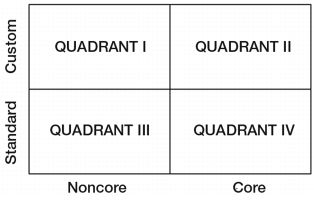A quadrant approach classifies Postal Service purchases into four categories, depending on their impact on the Postal Service core competencies (noncore versus core) and complexities (standard versus custom). Depending on the quadrant, material planning activities will focus on different areas of unique planning activities and material logistics, as illustrated in Figure 5.4.
Figure 5.4
Quadrant Approach

There are few options, one or restricted supplier sources, and supply continuity is imperative for materials. Planning activities surrounding the materials schedule, such as key delivery dates and close contact with suppliers, will need to be conducted for materials in this quadrant.
Materials are vital to operations, are of high value, and there are few sources. The logistical areas of custody/safeguarding and material storage are of great importance and must be addressed by the material planning activities.
Many options and sources for materials, coupled with minimal brand preference, can lead to reduced purchase efforts and associated costs. Actions that can be taken are automation and reducing administrative costs (i.e., reporting and recording).
Materials have many alternatives, many sources, and are readily available in the marketplace. Particular attention should be given to recovery because surplus in this quadrant is addressed as bringing in the highest dollar value, being greatest in inventory quantity, and offering easy logistics.
